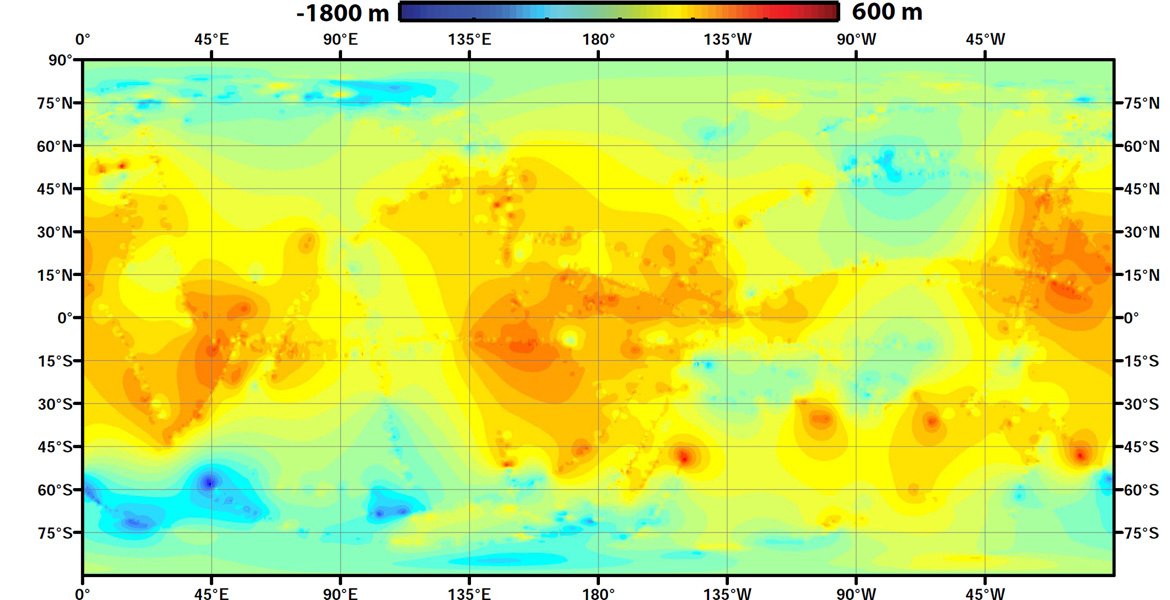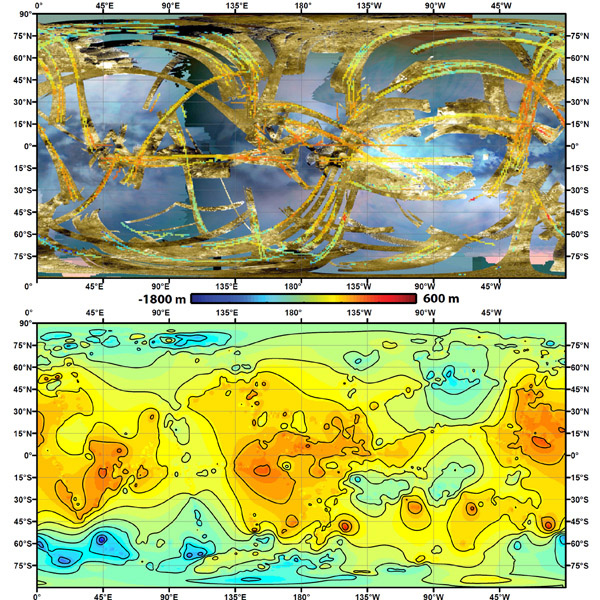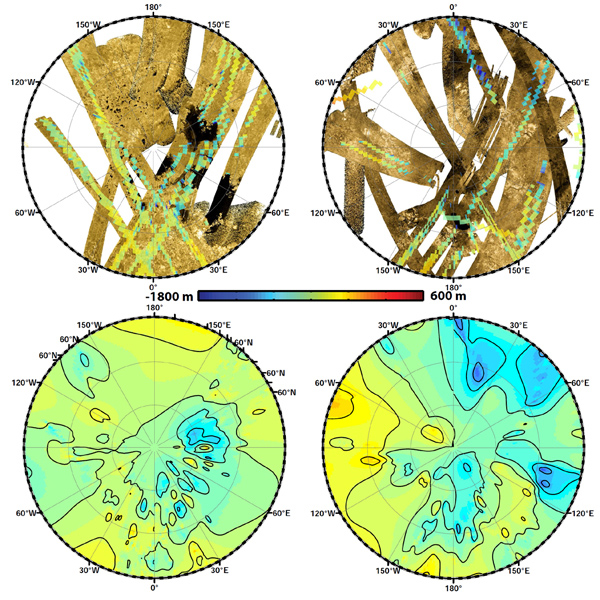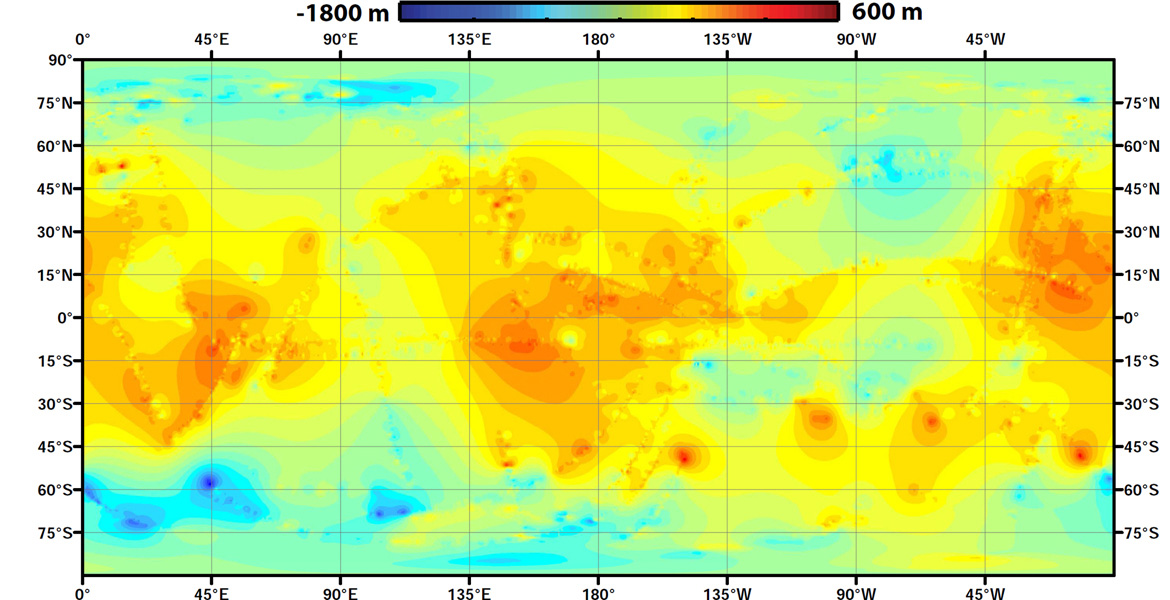First global topographic map of Titan, a world much like Earth

Scientists have created the first global topographic map of Saturn's moon Titan giving researchers a valuable tool for learning more about one of the most Earth-like and interesting worlds in the solar system. The map was just published as part of a paper in the journal Icarus.
Titan is Saturn's largest moon – with a radius of about 1,600 miles (2,574 kilometers), it's bigger than planet Mercury – and is the second-largest moon in the solar system. Scientists care about Titan because it's the only moon in the solar system known to have clouds, surface liquids and a mysterious, thick atmosphere. The cold atmosphere is mostly nitrogen, like Earth's, but the organic compound methane on Titan acts the way water vapor does on Earth, forming clouds and falling as rain and carving the surface with rivers. Organic chemicals, derived from methane, are present in Titan's atmosphere, lakes and rivers and may offer clues about the origins of life. (JPL)

Two Views of Titan's Topography
To create the first global, topographic map of Saturn's moon Titan, scientists analyzed data from NASA's Cassini spacecraft and a mathematical process called splining. This method effectively uses smooth curved surfaces to "join" the areas between grids of existing topography profiles obtained by Cassini's radar instrument. In the upper panel of this graphic, gold colors show where radar images have been obtained over almost half of Titan's surface. Within the gold areas, narrow strips of rainbow colors show where height data have been obtained. Those data are laid over a blue-toned, near-global map of infrared color from the Cassini visual and infrared mapping spectrometer instrument. The lower panel shows the new topography map, with contour lines added at 656 feet (200 meters) apart in elevation. South polar depressions and four mountains are notably prominent; a dark region at 50 to 65 degrees south latitude and 0 to 60 degrees east longitude coincides with a major depression.
The radar and VIMS data were obtained from 2004 to 2011.
The Cassini-Huygens mission is a cooperative project of NASA, the European Space Agency and ASI, the Italian Space Agency. JPL, a division of the California Institute of Technology in Pasadena, manages the mission for NASA's Science Mission Directorate, Washington. The radar instrument was built by JPL and the Italian Space Agency, working with team members from the US and several European countries.
Image credit: NASA/JPL-Caltech/ASI/JHUAPL/Cornell/Weizmann

Polar Views of Titan's Global Topography
These polar maps show the first global, topographic mapping of Saturn's moon Titan, using data from NASA's Cassini mission. The topography maps at bottom focus on the polar regions (north at left, south at right) in stereographic projection. The top maps show the 2-D radar data in gold and black, with topography data color-coded by elevation. The bottom images are from the new topography map, with contour lines added at 656 feet (200 meters) apart in elevation.
Visible are deep basins at 72 degrees south latitude and 20 degrees east longitude, and a wider basin at 68 degrees south latitude and 105 degrees east longitude.
The Cassini-Huygens mission is a cooperative project of NASA, the European Space Agency and ASI, the Italian Space Agency. JPL, a division of the California Institute of Technology in Pasadena, manages the mission for NASA's Science Mission Directorate, Washington. The radar instrument was built by JPL and the Italian Space Agency, working with team members from the US and several European countries.
Image credit: NASA/JPL-Caltech/ASI/JHUAPL/Cornell/Weizmann
"Titan has so much interesting activity – like flowing liquids and moving sand dunes – but to understand these processes it's useful to know how the terrain slopes," said Ralph Lorenz, a member of the Cassini radar team based at the Johns Hopkins University Applied Physics Laboratory, Laurel, Md., who led the map-design team. "It's especially helpful to those studying hydrology and modeling Titan's climate and weather, who need to know whether there is high ground or low ground driving their models."
Titan's thick haze scatters light in ways that make it very hard for remote cameras to "see" landscape shapes and shadows, the usual approach to measuring topography on planetary bodies. Virtually all the data we have on Titan comes from NASA's Saturn-orbiting Cassini spacecraft, which has flown past the moon nearly 100 times over the past decade. On many of those flybys, Cassini has used a radar imager, which can peer through the haze, and the radar data can be used to estimate the surface height.
"With this new topographic map, one of the most fascinating and dynamic worlds in our solar system now pops out in 3-D," said Steve Wall, the deputy team lead of Cassini's radar team, based at NASA's Jet Propulsion Laboratory in Pasadena, Calif. "On Earth, rivers, volcanoes and even weather are closely related to heights of surfaces – we're now eager to see what we can learn from them on Titan."

Global Topographic Map of Titan
Using data from NASA's Cassini spacecraft, scientists have created the first global topographic map of Saturn's moon Titan, giving researchers a 3-D tool for learning more about one of the most Earthlike and interesting worlds in the solar system. The estimations fit with current knowledge of the moon — that its polar regions are "lower" than areas around the equator, for example. But connecting those points allows scientists to add new layers to their studies of Titan's surface, especially those modeling how and where Titan's rivers flow, and the seasonal distribution of its methane rainfall.
The radar data were collected between 2004 and 2011.
Image credit: NASA/JPL-Caltech/ASI/JHUAPL/Cornell/Weizmann
There are challenges, however. "Cassini isn't orbiting Titan," Lorenz said. "We have only imaged about half of Titan's surface, and multiple 'looks' or special observations are needed to estimate the surface heights. If you divided Titan into 1-degree by 1-degree [latitude and longitude] squares, only 11 percent of those squares have topography data in them."
Lorenz's team used a mathematical process called splining – effectively using smooth, curved surfaces to "join" the areas between grids of existing data. "You can take a spot where there is no data, look how close it is to the nearest data, and use various approaches of averaging and estimating to calculate your best guess," he said. "If you pick a point, and all the nearby points are high altitude, you'd need a special reason for thinking that point would be lower. We're mathematically papering over the gaps in our coverage."
A world much like Earth

Presentation – Titan: A world with rivers, lakes, and possibly even life
Video published: March 9, 2011
Presentation by Dr. Chris McKay (NASA Ames Research Center)
In many ways, Titan is a cold twin of the Earth, with liquid methane playing the same role there as water plays on our planet. Life on Earth is based on liquid water; could there be life on Titan based on liquid methane? Dr. McKay (co-investigator on the Huygens probe that landed on Titan) discusses the new picture we have of this alien world, with its lakes, its rivers, and its rocks made of water ice.


Geological features of Titan


Revising topographic data in 2017
The most recent data used to compile the map is from 2012; Lorenz says it could be worth revising when the Cassini mission ends in 2017, when more data will have accumulated, filling some of the gaps in present coverage. "We felt we couldn't wait and should release an interim product," he says. "The community has been hoping to get this for a while. I think it will stimulate a lot of interesting work."
Source: NASA JPL
Featured image: NASA/JPL-Caltech/ASI/JHUAPL/Cornell/Weizmann

Commenting rules and guidelines
We value the thoughts and opinions of our readers and welcome healthy discussions on our website. In order to maintain a respectful and positive community, we ask that all commenters follow these rules:
We reserve the right to remove any comments that violate these rules. By commenting on our website, you agree to abide by these guidelines. Thank you for helping to create a positive and welcoming environment for all.